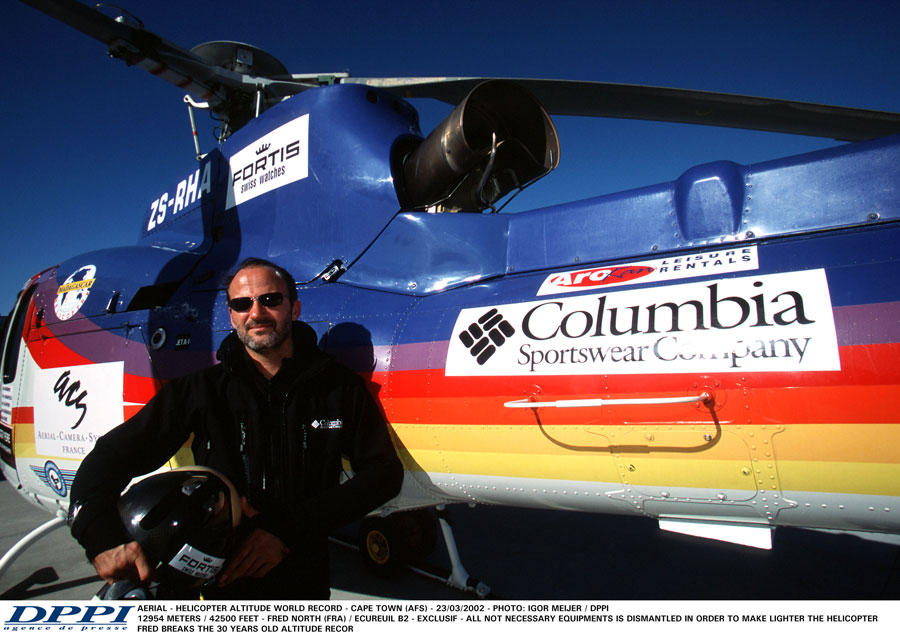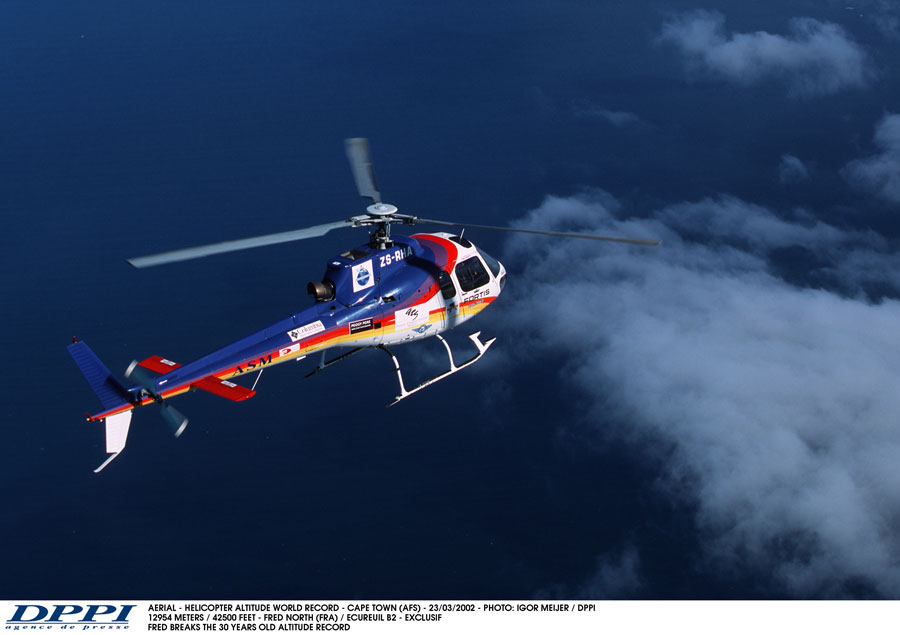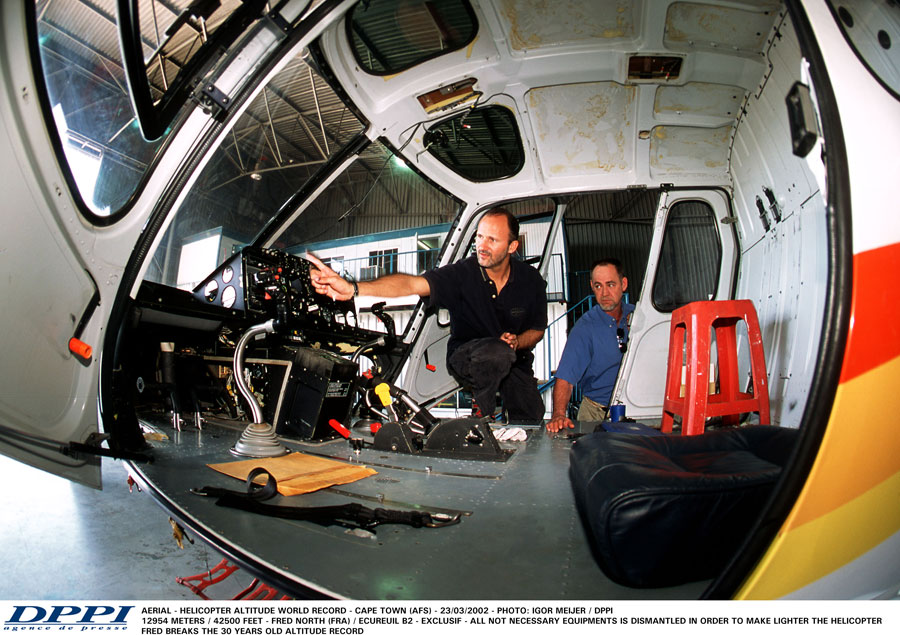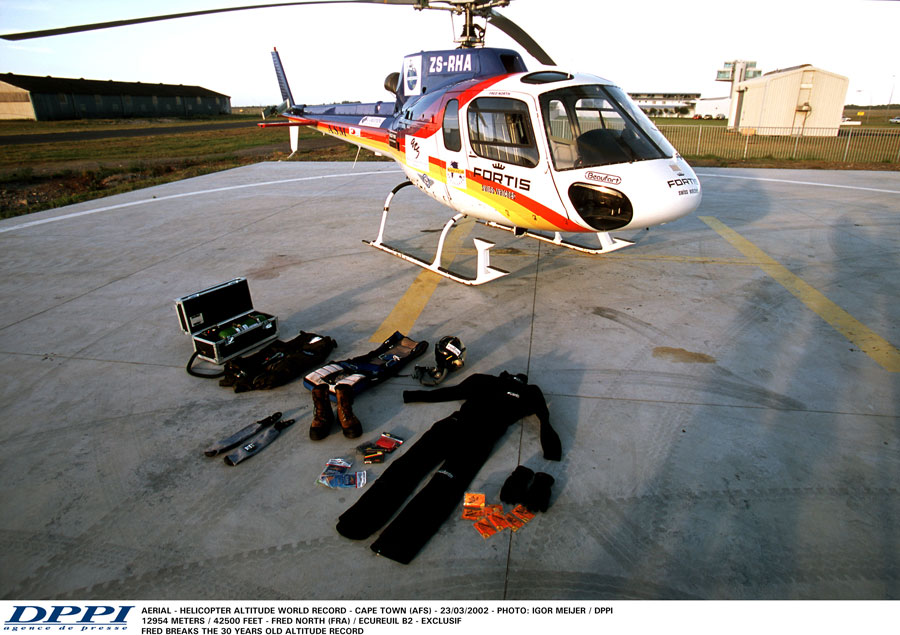by Helicopter – 42,500Ft
About thirty years after the record set by Jean Boulet on a SA315 B “Lama” helicopter, Fred North, professional pilot, takes an AS 350 B2 “Squirrel” to the fantastic altitude of 12954 m.
To beat the world record of altitude in a helicopter? During the past two years he thought of it. While he was starting up the turbine of his Squirrel AS350B2, on this Saturday 23rd of March 2002, at the International Airport of Cape Town, South Africa, Fred North didn’t feel like being a test pilot. Nor does he like being an illuminated suicidal. For this professional of helicopters who has 8500 hours of flight (including 5000 hours on Squirrel), head of his company specialised in aerial filming and passionated by his job, the challenge itself should be self-sufficient. In this case, no industrial ever asked him to jump into the adventure, nor any institutional authority. In fact, as soon as the idea came up to him, Fred North thought more of the technical, physical and psychological commitments, caused by such an approach. He bet as well on the pure aeronautics passion that this challenge would give. But on this day, the pilot was wondering if his audacity didn’t go too far. And in few seconds, the film of his life played back to him, reminding him what he had done to get there…
A master advice
A light 5-6 seats helicopter, no matter which one, was not built to fly that high. This type of aircraft was more likely to do short connections at low altitude, while having the necessary infrastructures peculiar to planes. On the other hand, flights in the mountains often required highly powerful helicopters capable of exceptional taking off. In its own time the SA315B “Lama” met this need. It worked so well that dozens of them are still operating nowadays, especially in mountainous areas. Even so the weight/power ratio was less lucrative than the lama’s, the AS350 B2 “Squirrel” helicopter met as well the needs of the aerial operators asked to work in inaccessible zones particularly in altitude. When he decided to go through with his record project, Fred North didn’t think twice. His attempt, he would do it on a B2 Squirrel. But his target, even with a modem and trustful engine, still had to go through more difficulties. During the previous months, before the D-day, Fred approached the manufacturer and the motorist (Eurocopter and Turbomeca) while contacting the Civil aviation Authority, representing the French Minister of Transports. None of these three would value this quite peculiar request. The unfortunate negative answers from the “officials”, pointed out the risk incurred by Fred North, risks judged vain even from the industry more concerned by the market than by “spectacular” performances. Nevertheless, precious help would come. And not the least important. Jean Boulet, the owner of the world record certified by the international aeronautics federation, re-opened his files and offered Fred North to consult his flight report,dated June 1972. This valuable document contained basic information. For this intrepid pilot, this help is going to be decisive.
Choice of the site and equipment on board
As the French ministry didn’t seem to authorise this record attempt, Fred North went in search of another more welcoming site. Why not South Africa?” I had good memories of aerial work I had over there. Furthermore, the weather conditions, at this time of the year, are ideal.
I remembered as well some conversations with South African glider pilots. For them rising wind currents were numerous and acted like pumps. I knew I would need them.” Fred explained. For the engine-the shipment of the Squirrel to Cape Town was over budget-, Dave Mouton, local aerial operator and boss of Heli Byp company, brought the answer to the problem. Instead of the motorised AS 350 B2, a new Arriel 1D1 was lent to the French pilot. Still two obstacles remained: the oxygen equipment and the study of the flight plan were needed to success. No way to pressurise the cabin of the Squirrel. Oxygen equipment and a special suit were specially studied for the pilot (including a parachute) and furnished by an American firm. The flight parameters were entrusted to Daniel Le Godec, an outstanding technician, and director of the company Air Service Maintenance. “More than preparing the helicopter technically, we had to elaborate performance arithmetic’s as precisely as possible regarding the peculiar parameters that Fred would have to go through”, points out Daniel Le Godec. Thanks to Jean Boulet flight report; Daniel and Fred managed to extrapolate mathematically the flight curves and to project the lines that the AS 350 B2 would logically follow. At the end of his calculation, the director of Air Service Maintenance estimated the needed time of flight to reach the objective should be 1 hour and 29 minutes. Finally, it would be done in 1 hour and 35 minutes…
The parachute strap
International airport of Cape Town, South Africa. The weather was fantastic. 200 kilos Lighter compare to its normal configuration, the Squirrel took off. Total weight of 1048 kilos. With 25% of fuel in the tank (132 litres) and minimum equipment on board – a little VHP radio, verticalmeter, un altimeter, the instrument engine indicators and transponder mode C-Fred crossed his fingers. His trust in his colleagues was total. But it was on his shoulders that the hopes relied. The South African civil aviation authorities, enthusiastic, watched over. His friends, tense but happy for him, were supporting him. No reverse gear was possible! “I didn’t want to do it anymore. Too much pressure and the risks even though they were calculated; it was difficult on a psychological level. But of course it was too late to give up…”confessed Fred North. A previous test flight had been necessary for the pilot to understand the high altitude-he went up to 10000 m “just to have a look” – but still the uncomfortable unknown remained.
The ascent started. Everything was fine on board. Stress was rising and would be present all the way through. Fred didn’t enjoy the view of the clear blue sky. The magnificent Cape of Good-Hope showed the extreme limits of the continent in between the two oceans. The sunlight, getting brighter and brighter, irradiated the interior of the Squirrel. His oxygen mask was giving little by little the vital air to the pilot. The turbine and the rotor worked properly. The 8000 meters were almost reached. At this altitude, physical risks became real. In fact it would be really risky if he wasn’t wearing his thorax compression jacket, as the air in his lungs without external pressure could kill him. Saying so, something started to bother him. More and more he was going up toward the big blue, the pilot felt his jacket blowing abnormally. He started to have trouble breathing. A quick call on the radio to the technicians on the ground confirmed his intuition. The regulator valve pressure didn’t work properly. If he didn’t act quickly, Fred might suffocate. The problem was located: his parachute strap, tightened on his shoulder, stubbed out the valve. With his left hand, Fred managed to put his fingers through his suit, and in extremis, to deflate the mad jacket. After few anxious minutes, the pilot was breathing normally again. He had made it.
“This guy is crazy”
This unwanted test didn’t diminish his mental strength. Confidence was coming back to him. But he still needed to go further up. The atmosphere, in the cabin, was unreal. The distance between the ground and Fred was growing. Breathtaking. 38500 feet. On the radio frequency, a human voice breaks into the cold silence. “What’s that?” questioned the B-747 pilot from South African Airways, flying in the area. On his radar, an unusual echo. “It is just a French man who is attempting to break the world record on a helicopter. Don’t worry…” answered the air traffic controller of Cape Town. “Is he crazy?” yelled the pilot of the Boeing. Fred didn’t miss a word. And what if he was right? The comic of the situation didn’t eliminate all the efforts made during those last months. No Fred was not crazy. Or just enough to exceed the limits. But the pilot didn’t think about that. He had other priorities! As they thought, the higher it went, the slower the Squirrel got. The power of the engine was four times less in this atmosphere than at a lower altitude. He had to keep on getting the rising currents, the famous pump. The minutes stretched little by little. Psychological pressure was high. Higher, higher and higher… The vibrating waves that the rotor made was unusual. Mechanically, the engine arrived at its higher level of performance. The helicopter went up and down and up again. Fred fought with the stratospheric molecules. It had been an hour and a half that he was in the air. The limits had been reach. It was time to go down now. The previous experience of Jean Boulet shared, Fred decreased slowly the collective pitch to avoid a flame out and engine failure. Everything was fine. The helicopter was slowly going down. A more frank pressure on the collective pitch and… the turbine shut down. They thought of it. On autorotation, the Squirrel kept on track. The pilot remembered the best moment to restart the motor. At 14000 feet, the turbine can be reactivated and the engine can continue normally. Fred North got back to the departure point, happy but exhausted. “I will never do it again!”. As a message from the heart, as a confession, these words tell us a story. The story of a man who kept his engagements, who went over his own resistance limits, over old demons, over the 12954 meters, somewhere unfathomable.
The World record was not monitored nor registered by the Federation Aeronautique Internationale. (FAI)
































